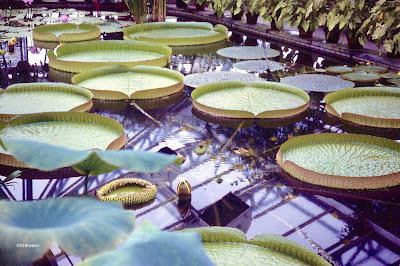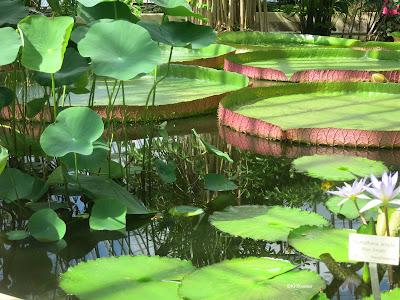It is one of the wonders of the world. A water-lily with leaves 8' in diameter and beautiful fragrant flowers nearly 12" across. It would have been famous in any event, but it was discovered for England in 1836 in British Guiana by Robert Schomburgk, just as Queen Victoria was about to become Queen of England. Members of the British botanical and geographical communities, individually and collectively, dedicated it to Queen Victoria. So they named it Victoria regia in her honor. (Not without controversy, see Flower of Empire for a detailed story).
 |
| Victoria water-lilies on the upper Amazon in Peru |
Today you can see it growing in many botanic gardens or buy seeds if you want to try for yourself. Today it is called Victoria amazonica, with two other species in the genus, the largest described in July 2022. I'll explain all that. But when I saw the plant in Amazonian Peru, I was struck by its botany, not its name or history. So this became a two-part blog, one on the finding and naming of it, and the other on it as a plant (botany).
The history of Europeans discovering this water-lily is a good story. The English found it in their colony British Guiana in 1836 and named it for Queen Victoria, but could only show sketches of the plant to the British people. So they pushed to bring live plants to England. That was not easy. Schomburgk, the discoverer, returned to the flooded Guianan forests and gathered plants and seeds. By the time he returned to Georgetown, the capital, the plants were mush, but he sent the seeds to England. The seeds did not germinate.
Even if they had germinated, British botanists would have had difficult time keeping the seedlings alive. Glasshouse (hothouse, greenhouse) technology was new. Growing tropical plants in northern Europe had only just become possible--leading to vast collections of orchids by noblemen. It required good heating systems, well-made clear glass, and a strong frame to hold the weight of the glass. Furthermore, a water-lily needs a pond, not just a shelf like an orchid. A well-lit pond with warm good-quality water was a significant challenge.
Ah, but not just a pond. A BIG pond, where the giant water-lily might grow several leaves 8 feet in diamater.
The botanical elite in England built and tested frantically in hope of receiving Victoria water-lilies to grow.
 |
| Victoria water-lilies in botanical garden in Berlin (1987) |
Rhizomes, live plants, and seeds were repeatedly sent to England--after being collected at great effort in the South American interior--over the next decade. Finally in 1849 a new shipment of seeds germinated in the hands of John Paxton, head gardener of the Duke of Devonshire in the Duke's state-of-the-art glasshouse at Chatsworth. With gentle water circulation in a shallow, well-lit pool, the water-lilies grew rapidly. In November, 1849, first one and then another bloomed. The seeds had been shared with the royal gardens at Kew, other noble plant enthusiasts, and prominent nurserymen, so soon after, Victoria water-lilies were being grown in various locations in Europe. They grew them as annuals. The plants will flower and produce viable seeds within the year, and, especially when hand-pollinated by devoted botanists, viable seeds can be produced to plant the next spring.
The Victoria water-lily drove major progress in greenhouses and managing tropical plants.
It was a source of British pride. It had the largest leaves known (for area, not length), beautiful flowers, and was from a British colony. In the 1830s and 1840s England got lots of bragging rights, but subsequent investigation has given us a slightly different story. The first European to see the giant water-lily was actually Bohemian Thaddeus Haenke in 1801. In 1819 the plant was described by Aime Bonpland, a French botanist accompanying the German von Humbolt in Brazil, and in 1832 Eduard Poeppig published a formal description of it as Euryale amazonica. Its status as a genus distinct from Euryale has been sustained, but Poeppig's name has precedence, so the plant is currently called Victoria amazonica.
Nor is it the largest water-lily. A second, slightly smaller, species, Victoria cruiziana, found south of the range of V. amazonica in the Paraguay and Parana Rivers, was recognized when the early observations and collections were sorted out. This July, a paper by a team at Kew Gardens recognized Bolivian Victoria water-lilies as a separate species, Victoria boliviana. These water-lilies are from a restricted area in eastern Bolivia. They grow larger than Victoria amazonica; a leaf of Victoria boliviana was measured at 10 and a half feet in diameter.
There is likely more to come; Smith et al., authors of the 2022 paper that named Victoria boliviana, believe there is a fourth species from a more central western location, but with insufficient information to be sure. (Ah, an alluring project: You float on tropical rivers studying fantastic water-lilies, in the pleasant tropical night if you want to see the fragrant white flowers open. Romantic, well, except for the big alligators, disease-carrying mosquitos, and other hazards. Or do those dangers make it sound even more intriguing? Whichever, notice that botanical discoveries are still happening and field studies are still needed.)
To summarize, the giant water-lily from the Amazon was so large and spectacular that the British named it for Queen Victoria. In trying to grow this special plant, British horticulturalists developed better and better greenhouses and vastly improved their skills at growing tropical plants. Victoria water-lilies hold the "world's biggest leaf" record and now there are three species. Very cool. All over the world, greenhouses and botanic gardens have planted Victoria water-lilies this spring and are watching the leaves expand. (There's a great video of leaf expansion on Kew Garden's Facebook page, but I don't see how to link to it for you.) When visiting aquatic plant displays this summer, look for the giant water-lilies with their grand platter-like leaves and huge white, pink, or maroon flowers.
 |
| Victoria water-lily leaves beyond lotus, Nelumbo (left) and Egyptian waterliles, Nymphaea (right, flowering) in Botanic Garden, Stockholm |
Comments and corrections welcome.
Spelling: dictionaries on Google say it is two words, water lily. Smith et al. write water lily. (They're British, from Kew Gardens.) The Flora of North America and the USDA Plants data base hyphenate: water-lily. I followed the American botanists. Water-lilies are in a family of their own, Nymphaceae, which is quite distinct from lilies, plant family Liliaceae. Making a hyphenated name reinforces that point.
Coincidence:; I drafted this post this June before the Smith et al. paper appeared. Strange timing. I'm grateful: the Smith et al. paper is great reading, and it answered many of my questions!
References
Brewer, G. 2022. Uncovering the Giant Waterlily, A botanical wonder of the world. Kew Gardens link (Accessed 7/8/22). Popular article, terrific photos.
Holloway, T. 2013. Flower of Empire. An Amazonian Water Lily the Quest to Make it Bloom and the World it Created. Oxford University Press. London.
Smith, L. T., C. Magdalena, N.A.S. Przeomaska, O.A. Pérez-Escobar, D. G. Melgar-Gómez, S.Beck, R. Negrão, S. Mian, I. J. Leitch, S. Dodsworth, O. Maurin, G. Ribero-Guardia, C.D. Salazar, G. Gutierrez-Sibauty, A. Antonelli and A.K. Monro 2022. Revised species delimitation in the giant water lily genus Victoria (Nymphaceae) confirms a new species and has implications for conservation. Frontiers of Plant Science. 13: 883151. doi: 10.3389/pls.2922,883151. link This is the technical paper, but it is open access and full of interesting stuff, from color photos and maps to comparision charts for the species to their methods of using iNaturalist and social media photos in the analysis. (Accessed 7/8/22).
What is the World's Largest Leaf? The Garden of Eaden https://gardenofeaden.blogspot.com/2015/07/what-is-worlds-largest-leaf.html (Accessed 7/8/22)
Kathy Keeler, A Wandering Botanist
More at awanderingbotanist.com
Join me on Facebook: https://www.facebook.com/AWanderingBotanist
Hi Kathy! I’ve been following your blog for a few months, occasionally checking in to see your new posts. This was a great read, and I’m so glad you have this blog up, thank you!
ReplyDeletenice post!Dwarf victoria lily is a stunning aquatic plant known for its unique beauty and elegance.
ReplyDelete